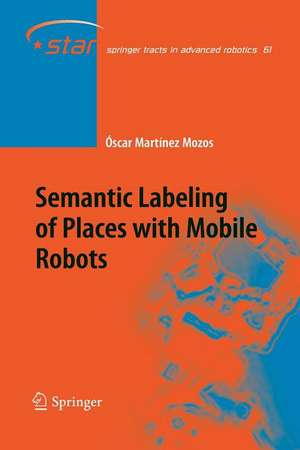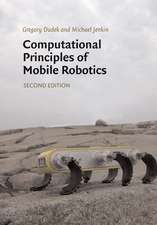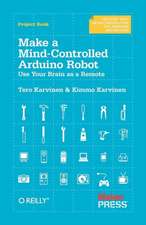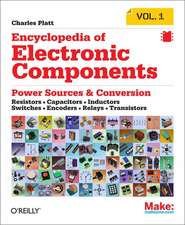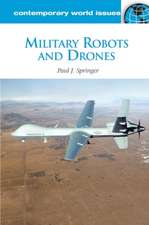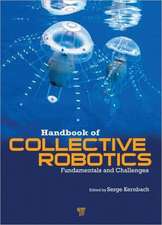Semantic Labeling of Places with Mobile Robots: Springer Tracts in Advanced Robotics, cartea 61
Autor Óscar Martinez Mozosen Limba Engleză Paperback – 4 mai 2012
This book presents several approaches to enable a mobile robot to categorize places in indoor environments. The categories are indicated by terms which represent the different regions in these environments. The objective of this work is to enable mobile robots to perceive the spatial divisions in indoor environments in a similar way as people do. This is an interesting step forward to the problem of moving the perception of robots closer to the perception of humans. Many approaches introduced in this book come from the area of pattern recognition and classification. The applied methods have been adapted to solve the specific problem of place recognition. In this regard, this work is a useful reference to students and researchers who want to introduce classification techniques to help solve similar problems in mobile robotics.
| Toate formatele și edițiile | Preț | Express |
|---|---|---|
| Paperback (1) | 550.14 lei 38-44 zile | |
| Springer Berlin, Heidelberg – 4 mai 2012 | 550.14 lei 38-44 zile | |
| Hardback (1) | 639.90 lei 6-8 săpt. | |
| Springer Berlin, Heidelberg – 4 feb 2010 | 639.90 lei 6-8 săpt. |
Din seria Springer Tracts in Advanced Robotics
- 18%
 Preț: 910.26 lei
Preț: 910.26 lei - 18%
 Preț: 893.71 lei
Preț: 893.71 lei -
 Preț: 445.98 lei
Preț: 445.98 lei -
 Preț: 406.44 lei
Preț: 406.44 lei -
 Preț: 523.44 lei
Preț: 523.44 lei - 17%
 Preț: 378.36 lei
Preț: 378.36 lei - 15%
 Preț: 640.88 lei
Preț: 640.88 lei - 18%
 Preț: 783.98 lei
Preț: 783.98 lei - 15%
 Preț: 641.74 lei
Preț: 641.74 lei - 15%
 Preț: 640.88 lei
Preț: 640.88 lei - 18%
 Preț: 994.72 lei
Preț: 994.72 lei - 18%
 Preț: 778.45 lei
Preț: 778.45 lei - 18%
 Preț: 730.35 lei
Preț: 730.35 lei - 18%
 Preț: 1233.83 lei
Preț: 1233.83 lei - 18%
 Preț: 951.47 lei
Preț: 951.47 lei - 15%
 Preț: 640.06 lei
Preț: 640.06 lei - 18%
 Preț: 1844.67 lei
Preț: 1844.67 lei - 15%
 Preț: 642.51 lei
Preț: 642.51 lei - 18%
 Preț: 1112.30 lei
Preț: 1112.30 lei - 15%
 Preț: 665.08 lei
Preț: 665.08 lei - 18%
 Preț: 947.85 lei
Preț: 947.85 lei - 15%
 Preț: 640.88 lei
Preț: 640.88 lei - 18%
 Preț: 776.88 lei
Preț: 776.88 lei - 18%
 Preț: 959.04 lei
Preț: 959.04 lei - 15%
 Preț: 659.02 lei
Preț: 659.02 lei - 15%
 Preț: 654.95 lei
Preț: 654.95 lei - 18%
 Preț: 973.38 lei
Preț: 973.38 lei - 5%
 Preț: 724.70 lei
Preț: 724.70 lei - 18%
 Preț: 981.49 lei
Preț: 981.49 lei - 18%
 Preț: 954.45 lei
Preț: 954.45 lei - 15%
 Preț: 641.53 lei
Preț: 641.53 lei - 15%
 Preț: 653.98 lei
Preț: 653.98 lei - 24%
 Preț: 814.83 lei
Preț: 814.83 lei - 18%
 Preț: 968.65 lei
Preț: 968.65 lei - 18%
 Preț: 970.70 lei
Preț: 970.70 lei
Preț: 550.14 lei
Preț vechi: 687.68 lei
-20% Nou
Puncte Express: 825
Preț estimativ în valută:
105.28€ • 109.51$ • 86.92£
105.28€ • 109.51$ • 86.92£
Carte tipărită la comandă
Livrare economică 10-16 aprilie
Preluare comenzi: 021 569.72.76
Specificații
ISBN-13: 9783642262371
ISBN-10: 3642262376
Pagini: 160
Ilustrații: XXI, 138 p.
Dimensiuni: 155 x 235 x 8 mm
Greutate: 0.25 kg
Ediția:2010
Editura: Springer Berlin, Heidelberg
Colecția Springer
Seria Springer Tracts in Advanced Robotics
Locul publicării:Berlin, Heidelberg, Germany
ISBN-10: 3642262376
Pagini: 160
Ilustrații: XXI, 138 p.
Dimensiuni: 155 x 235 x 8 mm
Greutate: 0.25 kg
Ediția:2010
Editura: Springer Berlin, Heidelberg
Colecția Springer
Seria Springer Tracts in Advanced Robotics
Locul publicării:Berlin, Heidelberg, Germany
Public țintă
ResearchCuprins
Supervised Learning.- Semantic Learning of Places from Range Data.- Topological Map Extraction with Semantic Information.- Probabilistic Semantic Classification of Trajectories.- Semantic Information in Exploration and Localization.- Conceptual Spatial Representation of Indoor Environments.- Semantic Information in Sensor Data.- Conclusion.
Textul de pe ultima copertă
During the last years there has been an increasing interest in the area of service robots. Under this category we find robots working in tasks such as elderly care, guiding, office and domestic assistance, inspection, and many more. Service robots usually work in indoor environments designed for humans, with offices and houses being some of the most typical examples. These environments are typically divided into places with different functionalities like corridors, rooms or doorways. The ability to learn such semantic categories from sensor data enables a mobile robot to extend its representation of the environment, and to improve its capabilities. As an example, natural language terms like corridor or room can be used to indicate the position of the robot in a more intuitive way when communicating with humans.
This book presents several approaches to enable a mobile robot to categorize places in indoor environments. The categories are indicated by terms which represent the different regions in these environments. The objective of this work is to enable mobile robots to perceive the spatial divisions in indoor environments in a similar way as people do. This is an interesting step forward to the problem of moving the perception of robots closer to the perception of humans. Many approaches introduced in this book come from the area of pattern recognition and classification. The applied methods have been adapted to solve the specific problem of place recognition. In this regard, this work is a useful reference to students and researchers who want to introduce classification techniques to help solve similar problems in mobile robotics.
This book presents several approaches to enable a mobile robot to categorize places in indoor environments. The categories are indicated by terms which represent the different regions in these environments. The objective of this work is to enable mobile robots to perceive the spatial divisions in indoor environments in a similar way as people do. This is an interesting step forward to the problem of moving the perception of robots closer to the perception of humans. Many approaches introduced in this book come from the area of pattern recognition and classification. The applied methods have been adapted to solve the specific problem of place recognition. In this regard, this work is a useful reference to students and researchers who want to introduce classification techniques to help solve similar problems in mobile robotics.
Caracteristici
Firsts book on semantic information about places using mobile robots Interesting example of how to use machine learning techniques with mobile robots to solve new problems
